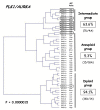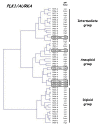Expression analysis of mitotic spindle checkpoint genes in breast carcinoma: role of NDC80/HEC1 in early breast tumorigenicity, and a two-gene signature for aneuploidy
- PMID: 21352579
- PMCID: PMC3058099
- DOI: 10.1186/1476-4598-10-23
Expression analysis of mitotic spindle checkpoint genes in breast carcinoma: role of NDC80/HEC1 in early breast tumorigenicity, and a two-gene signature for aneuploidy
Abstract
Background: Aneuploidy and chromosomal instability (CIN) are common abnormalities in human cancer. Alterations of the mitotic spindle checkpoint are likely to contribute to these phenotypes, but little is known about somatic alterations of mitotic spindle checkpoint genes in breast cancer.
Methods: To obtain further insight into the molecular mechanisms underlying aneuploidy in breast cancer, we used real-time quantitative RT-PCR to quantify the mRNA expression of 76 selected mitotic spindle checkpoint genes in a large panel of breast tumor samples.
Results: The expression of 49 (64.5%) of the 76 genes was significantly dysregulated in breast tumors compared to normal breast tissues: 40 genes were upregulated and 9 were downregulated. Most of these changes in gene expression during malignant transformation were observed in epithelial cells.Alterations of nine of these genes, and particularly NDC80, were also detected in benign breast tumors, indicating that they may be involved in pre-neoplastic processes.We also identified a two-gene expression signature (PLK1 + AURKA) which discriminated between DNA aneuploid and DNA diploid breast tumor samples. Interestingly, some DNA tetraploid tumor samples failed to cluster with DNA aneuploid breast tumors.
Conclusion: This study confirms the importance of previously characterized genes and identifies novel candidate genes that could be activated for aneuploidy to occur. Further functional analyses are required to clearly confirm the role of these new identified genes in the molecular mechanisms involved in breast cancer aneuploidy. The novel genes identified here, and/or the two-gene expression signature, might serve as diagnostic or prognostic markers and form the basis for novel therapeutic strategies.
Figures





Similar articles
-
Increased expression of mitotic checkpoint genes in breast cancer cells with chromosomal instability.Clin Cancer Res. 2006 Jan 15;12(2):405-10. doi: 10.1158/1078-0432.CCR-05-0903. Clin Cancer Res. 2006. PMID: 16428479
-
Frequent impairment of the spindle assembly checkpoint in hepatocellular carcinoma.Cancer. 2002 Apr 1;94(7):2047-54. doi: 10.1002/cncr.10448. Cancer. 2002. PMID: 11932908
-
Expression and mutational analyses of the human MAD2L1 gene in breast cancer cells.Genes Chromosomes Cancer. 2000 Dec;29(4):356-62. doi: 10.1002/1098-2264(2000)9999:9999<::aid-gcc1044>3.0.co;2-n. Genes Chromosomes Cancer. 2000. PMID: 11066082
-
Aneuploidy: Cancer strength or vulnerability?Int J Cancer. 2019 Jan 1;144(1):8-25. doi: 10.1002/ijc.31718. Epub 2018 Oct 31. Int J Cancer. 2019. PMID: 29981145 Free PMC article. Review.
-
Aneuploidy and malignancy: an unsolved equation.J Clin Pathol. 2004 Dec;57(12):1245-9. doi: 10.1136/jcp.2004.018952. J Clin Pathol. 2004. PMID: 15563660 Free PMC article. Review.
Cited by
-
Bioinformatic analysis revealing mitotic spindle assembly regulated NDC80 and MAD2L1 as prognostic biomarkers in non-small cell lung cancer development.BMC Med Genomics. 2020 Aug 14;13(1):112. doi: 10.1186/s12920-020-00762-5. BMC Med Genomics. 2020. PMID: 32795325 Free PMC article.
-
Involvement of the FOXO6 transcriptional factor in breast carcinogenesis.Oncotarget. 2017 Dec 30;9(7):7464-7475. doi: 10.18632/oncotarget.23779. eCollection 2018 Jan 26. Oncotarget. 2017. PMID: 29484124 Free PMC article.
-
N-terminus-modified Hec1 suppresses tumour growth by interfering with kinetochore-microtubule dynamics.Oncogene. 2015 Jun;34(25):3325-35. doi: 10.1038/onc.2014.265. Epub 2014 Aug 18. Oncogene. 2015. PMID: 25132262
-
shRNA‑mediated knockdown of KNTC1 inhibits non-small-cell lung cancer through regulating PSMB8.Cell Death Dis. 2022 Aug 6;13(8):685. doi: 10.1038/s41419-022-05140-w. Cell Death Dis. 2022. PMID: 35933405 Free PMC article.
-
Identification of differentially expressed genes-related prognostic risk model for survival prediction in breast carcinoma patients.Aging (Albany NY). 2021 Jun 26;13(12):16577-16599. doi: 10.18632/aging.203178. Epub 2021 Jun 26. Aging (Albany NY). 2021. PMID: 34175839 Free PMC article.
References
Publication types
MeSH terms
Substances
LinkOut - more resources
Full Text Sources
Medical
Miscellaneous

